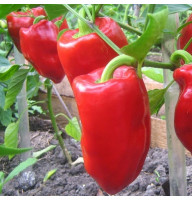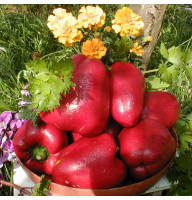Caring for heat-loving peppers in open ground has its own nuances and tricks. Nevertheless, many gardeners here manage to harvest quite a good pepper harvest.
Let's remember together the stages of technology and the secrets of growing pepper in open ground, so that in August-September you can enjoy the harvest of this healthy and tasty vegetable. And at the end of the article, you can download a very concise and useful calendar-plate for caring for peppers in open ground, so that when any questions arise, it will always be at hand.

Prepare the place for planting peppers in the fall. Neutral sandy and loamy soils, on which related nightshades (for example, tomatoes, potatoes or eggplants) have not previously grown, are suitable for it. your plants can «inherit» a number of diseases remaining in the soil. Pepper especially loves small hills, where the soil warms up better. Before the onset of autumn frosts, dig up the soil in the garden bed, adding a bucket of compost mixed with 20 g of superphosphate per 1 sq.m. If you did not have time to fertilize the soil ahead of time, you can do it in the spring (a bucket of humus + 1 cup of ash per 1 sq.m.).
In addition, you must decide in advance on the variety of pepper that you are going to plant - not everyone is suitable for open ground! The variety must be cold-resistant (after all, our climate is not southern), early enough (to have time to fully form the fruits) and «be able» to quickly and amicably increase the yield during a favorable period, which in the middle zone does not last long.
Today, quite a few varieties and hybrids of pepper already meet these requirements. We invite you to familiarize yourself with those that have long been loved by our gardeners and have passed multiple tests.

The seeds of these varieties of sweet peppers should be sown for seedlings in early March. If you have forgotten how to properly grow healthy and strong pepper seedlings at home, we will remind you.
Pepper seedlings are usually planted in open ground at the very beginning of June, when the threat of return frosts has completely disappeared. It is not recommended to bury young pepper plants. But it would be a good idea to sprinkle the soil around them with peat. And don’t forget to water each bush with 0.5 liters of water.

If it suddenly gets colder again, the bed must be covered with plastic film or non-woven material. Only in this case will the plants thank you with a generous harvest of sweet, colorful fruits. Please note that this can be done in two ways - either build a simple frame of arcs about 70 cm wide over the bed, or cover it closely with material, and then make holes in the flooring in which to plant the peppers. In the latter case, the plants will acclimatize better and suffer less, and the need for regular weeding will disappear.

The film of such an improvised greenhouse can be safely left over the pepper for a couple of weeks, or even until the end of June. All this time, the plantings should be looked after - watered, loosened the soil, applied fertilizers and ventilated shelters in sunny weather. The pepper takes root well under the film, increases its vegetative mass and begins to bloom. With the arrival of stable warm weather, the need for covering material disappears, and it can be safely removed.
To speed up the development of plants in open ground, peppers need to be fed. Do this as needed 2-4 times per season.
The first feeding is carried out two weeks after planting the plants in open ground (15 g of ammonium nitrate, 30 g of superphosphate and 25 g of potassium sulfate per 10 liters of water). You can also use complex fertilizer or bird droppings diluted in water (1:20).
The second feeding is carried out when ovaries form on the pepper. At the same time, the dosage is reduced (10 g of ammonium nitrate, 25 g of superphosphate and 25 g of potassium sulfate per 10 liters of water). Subsequent feeding is carried out only if necessary, if the plants’ development has slowed down.
Of course, you should not forget about timely protection of pepper from diseases and pests, especially if you notice that something is going wrong - for example, spots appear on the leaves or the fruits are deformed.
In order not to get confused, we suggest that you take note of our table and care for your pepper correctly.

And finally, it’s time to harvest the peppers! The growing season of pepper is about 120 days, so usually these dates in our latitudes fall at the end of August or September - and until the first frost.
The fruits are removed along with the tail, being careful not to damage them. And the harvested crop is stored by placing the peppers in rows in boxes in a cool room with high humidity. In such conditions, the vegetable feels great for a month.
And now the promised «squeeze» from all of the above - a convenient and useful calendar plate for caring for peppers in open ground. You just keep it at hand and no longer worry that you will forget the norms and timing of watering, loosening, fertilizing and other nuances of growing this vegetable. Now all the information is in one place!
We hope that our tips and calendar will really help you create favorable conditions for pepper in the open ground so that it will thank you with an excellent harvest this season.









